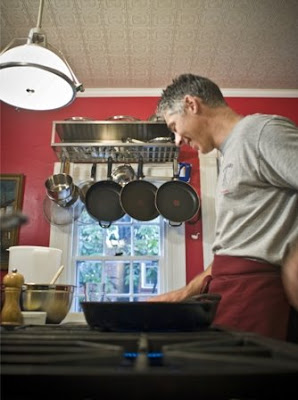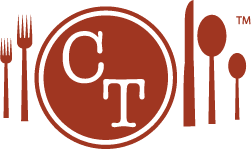 The Williamsburg Bridge serves as a kind of Yellow Brick Road gateway to the foodie enclave in Williamsburg, Brooklyn.
The Williamsburg Bridge serves as a kind of Yellow Brick Road gateway to the foodie enclave in Williamsburg, Brooklyn. I’m not a hipster. I can barely affect “hip.” When I do, it’s usually with the frequency of leap year.
I’ve heard legends of Williamsburg, but I always thought it was a colonial theme park in Virginia. Thankfully, there are people who can set me straight. Enter my college roommate “Ford McKenzie,” once a radical underground journalist and now a respectable member of the financial world, a home-canning expert, and a grass-fed beef addict. One night over Manhattan cocktails (which I introduced him to and he now has a clearly unhealthy obsession for) he informs me that Williamsburg (in Brooklyn, not Virginia) is the happening place where foodies go to play.
So, on the first sultry weekend of Spring I find myself trotting after Ford and his wife, Mrs. M, in the shadow of the Williamsburg Bridge and the skyline of Manhattan as we attempt to take a bite out of Brooklyn.
Ford has thoroughly briefed me on the nuances of Williamsburg. “If you put a fence around it you’d think you were on a college campus,” he tells me. There is certainly a youthful vibe. Half-naked, chiseled bodies whiz past us on skateboards or bicycles. Geeky-looking guys are locked arm-in-arm with gorgeous women. Here and there, someone carries a guitar slung over his shoulder. Amidst all this action, and a plethora of graffiti, we are three visitors in a strange land attempting to satisfy our hunger and quench our thirst. Dare I say it? “Toto, I get the feeling we’re not in Kansas anymore.”
You’d think we would have planned better. When foraging in the urban jungle, one must always bring ice packs and insulated totes. We haven’t, but we quickly establish a workable “layaway” system, in which we purchase now and pick up later.
At Marlow & Daughters, the young butchers are prepping sausage, which is made on site. The meat cases are bulging with intoxicating cuts of beef. We purchase a selection of sausage, all made from local pork.



Ford can’t resist a thick stack of pork chops. His standard preparation technique for pork chops is Shake & Bake, but these beauties might require more delicate handling.
Nearby, at Mast Brothers Chocolate, the cacao beans are ground on the premises. We sample artisanal Dark Chocolate Single Origin, and I can’t resist a bar of Dark Chocolate + Fleur de Sel …

 At the D.O.C. Wine Shop, rows of blushing rose are a welcomed rite of Spring …
At the D.O.C. Wine Shop, rows of blushing rose are a welcomed rite of Spring …
 We stop by the Bedford Cheese Shop and admire the lactose-inspired dairyscape …
We stop by the Bedford Cheese Shop and admire the lactose-inspired dairyscape …
 All this foraging has made us ravenous. We take a table at Marlow & Sons (a family tree might be helpful to fully comprehend the Marlow progeny present in Williamsburg) where we order Fried Eggs and Potatoes with House-Made Chorizo …
All this foraging has made us ravenous. We take a table at Marlow & Sons (a family tree might be helpful to fully comprehend the Marlow progeny present in Williamsburg) where we order Fried Eggs and Potatoes with House-Made Chorizo …

A huge stack of a sandwich made from house-cured meats and garnished with olives ….

 At the D.O.C. Wine Shop, rows of blushing rose are a welcomed rite of Spring …
At the D.O.C. Wine Shop, rows of blushing rose are a welcomed rite of Spring … We stop by the Bedford Cheese Shop and admire the lactose-inspired dairyscape …
We stop by the Bedford Cheese Shop and admire the lactose-inspired dairyscape … All this foraging has made us ravenous. We take a table at Marlow & Sons (a family tree might be helpful to fully comprehend the Marlow progeny present in Williamsburg) where we order Fried Eggs and Potatoes with House-Made Chorizo …
All this foraging has made us ravenous. We take a table at Marlow & Sons (a family tree might be helpful to fully comprehend the Marlow progeny present in Williamsburg) where we order Fried Eggs and Potatoes with House-Made Chorizo …
A huge stack of a sandwich made from house-cured meats and garnished with olives ….
And a crisp spinach salad dotted with tart, sweet cherries …
As the afternoon wanders on, we follow crowds of sun worshipers down to the shoreline of the East River, where the skyline of Manhattan glistens ….
 Intense thirst consumes us and we stop at Radegast Hall, a genuine Biergarten, where a crush of young graduate students sit at long tables consuming wurst, fries and buckets of ale imported from Germany …
Intense thirst consumes us and we stop at Radegast Hall, a genuine Biergarten, where a crush of young graduate students sit at long tables consuming wurst, fries and buckets of ale imported from Germany …


 Still a tad thirsty, we descend on the bar, Spuyten Duyvil for a few sips of raspberry ale imported from France …
Still a tad thirsty, we descend on the bar, Spuyten Duyvil for a few sips of raspberry ale imported from France …

 This kind of research is quite strenuous, and we are now famished, so we head for Fette Sau, a barbecue joint located in a former machine shop …
This kind of research is quite strenuous, and we are now famished, so we head for Fette Sau, a barbecue joint located in a former machine shop …
 The bar stools are made from tractor seats, and athletic bartenders race from end to end pouring flights of whisky …
The bar stools are made from tractor seats, and athletic bartenders race from end to end pouring flights of whisky …
 The beer taps have been customized with a range of razor-sharp items from Sweeney Todd’s tool box …
The beer taps have been customized with a range of razor-sharp items from Sweeney Todd’s tool box …
 I join the chow line, which is adjacent to long picnic tables where raucous groups indulge in communal gluttony. The brisket, pulled pork and Berkshire pork sausage is served on a sheet pan, which Ford slathers with different varieties of barbecue sauce …
I join the chow line, which is adjacent to long picnic tables where raucous groups indulge in communal gluttony. The brisket, pulled pork and Berkshire pork sausage is served on a sheet pan, which Ford slathers with different varieties of barbecue sauce …
 We try a flight of whisky, where vanilla is the predominant flavor note …
We try a flight of whisky, where vanilla is the predominant flavor note …
 Ford grabs another heaping tray of meat, this time with ribs, succulent, charred cheeks, and a slab of pork chop ….
Ford grabs another heaping tray of meat, this time with ribs, succulent, charred cheeks, and a slab of pork chop ….
 Intense thirst consumes us and we stop at Radegast Hall, a genuine Biergarten, where a crush of young graduate students sit at long tables consuming wurst, fries and buckets of ale imported from Germany …
Intense thirst consumes us and we stop at Radegast Hall, a genuine Biergarten, where a crush of young graduate students sit at long tables consuming wurst, fries and buckets of ale imported from Germany …

 Still a tad thirsty, we descend on the bar, Spuyten Duyvil for a few sips of raspberry ale imported from France …
Still a tad thirsty, we descend on the bar, Spuyten Duyvil for a few sips of raspberry ale imported from France …
 This kind of research is quite strenuous, and we are now famished, so we head for Fette Sau, a barbecue joint located in a former machine shop …
This kind of research is quite strenuous, and we are now famished, so we head for Fette Sau, a barbecue joint located in a former machine shop … The bar stools are made from tractor seats, and athletic bartenders race from end to end pouring flights of whisky …
The bar stools are made from tractor seats, and athletic bartenders race from end to end pouring flights of whisky … The beer taps have been customized with a range of razor-sharp items from Sweeney Todd’s tool box …
The beer taps have been customized with a range of razor-sharp items from Sweeney Todd’s tool box …  I join the chow line, which is adjacent to long picnic tables where raucous groups indulge in communal gluttony. The brisket, pulled pork and Berkshire pork sausage is served on a sheet pan, which Ford slathers with different varieties of barbecue sauce …
I join the chow line, which is adjacent to long picnic tables where raucous groups indulge in communal gluttony. The brisket, pulled pork and Berkshire pork sausage is served on a sheet pan, which Ford slathers with different varieties of barbecue sauce … We try a flight of whisky, where vanilla is the predominant flavor note …
We try a flight of whisky, where vanilla is the predominant flavor note … Ford grabs another heaping tray of meat, this time with ribs, succulent, charred cheeks, and a slab of pork chop ….
Ford grabs another heaping tray of meat, this time with ribs, succulent, charred cheeks, and a slab of pork chop ….We soar again, with a second flight of whisky. The marriage of whisky and barbecue is frankly quite thrilling, even for a couple of faux hipsters …
 And, we finish with a smoky splash of Wasmund’s Single Malt Whisky from Rappahonnock County, Virginia, topped with a big, chilly ice cube.
And, we finish with a smoky splash of Wasmund’s Single Malt Whisky from Rappahonnock County, Virginia, topped with a big, chilly ice cube.
 And, we finish with a smoky splash of Wasmund’s Single Malt Whisky from Rappahonnock County, Virginia, topped with a big, chilly ice cube.
And, we finish with a smoky splash of Wasmund’s Single Malt Whisky from Rappahonnock County, Virginia, topped with a big, chilly ice cube.






























